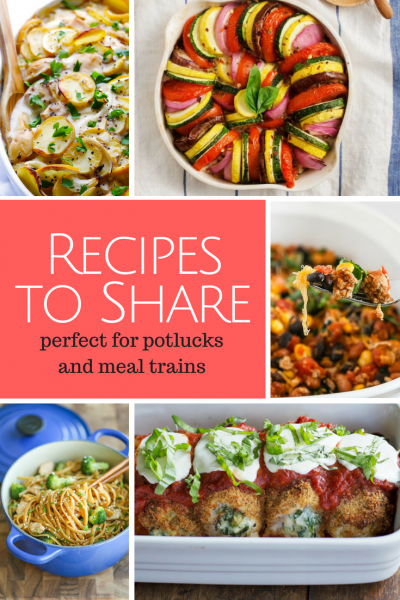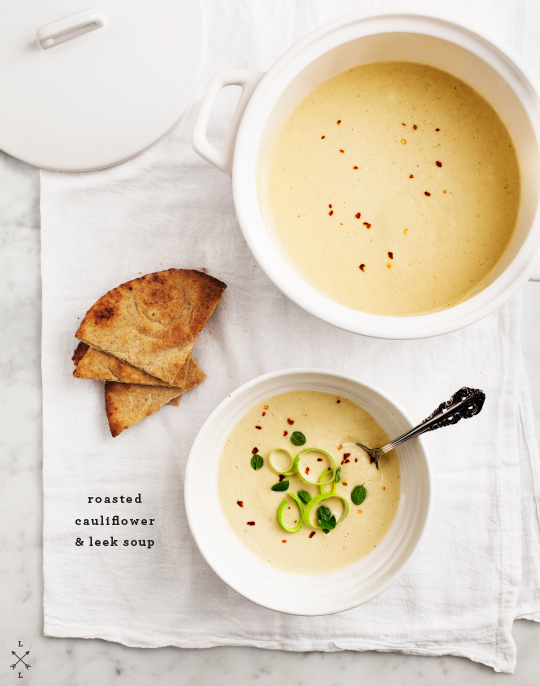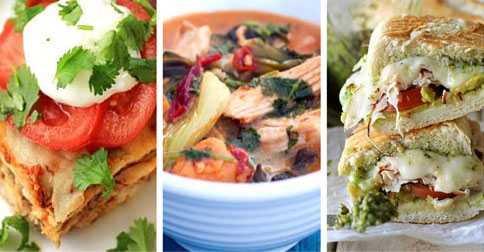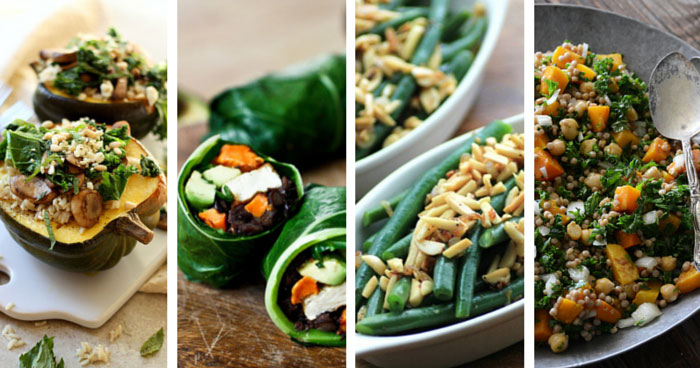Food to Share: Meal Train Recipes & Ideas
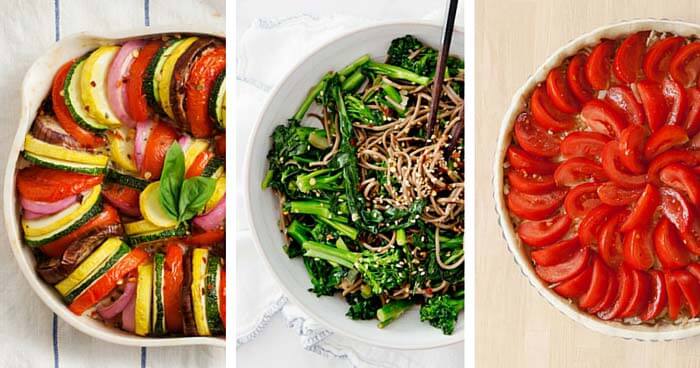
When I first heard the news that my friend’s father had died, I didn’t know what I could possibly say to ease her grief. Instead of trying, I offered to bring her family dinner. I hoped that in feeding her family, she would feel my love and support. I hoped that in saving her the time to shop for groceries and prepare food, she would have more energy to take care of herself when so many others were leaning on her. I hoped that by offering a comforting meal, food might help her when — really — nothing else could. I am not alone in feeling this instinct to reach out with food; countless others set up and join meal trains — collective efforts to feed and nurture those in need — every day.
When people we love go through transformative moments — the death of a loved one, serious illness, or bringing a new child into the world — we reach out to help them settle into new life patterns. Sometimes we can connect with sage and comforting advice, but when we can’t, food is usually a welcome offering.
In recent months, more than a few friends have found themselves in life-changing situations. Along with so many others, I’ve reached out to feed them. As I work to prepare meals, questions keep coming up about what and how and when to deliver. It has been awhile since I’ve been on the receiving end of meal sharing, and somehow my memories of what worked best are fuzzy. I know I’m not the only one with questions, so I’ve been asking for advice from friends who’ve recently benefited from shared meals. Their helpful, honest feedback offers plenty of food for thought. Following are some considerations to help deliver comfort and ease rather than any additional burden:
Decide Between Home Made or Prepared Options. A homemade meal prepared with love that can be easily heated and served is usually the favorite option, but if you don’t like to cook or don’t have the time, don’t kill yourself trying to make something yourself. If you have a hard time pulling off dinner for your own family, preparing a meal for someone else can feel like a burden rather than gift. Picking up or having take-out delivered — especially from a friend’s favorite spot — is a lovely alternative.
One working mom mentioned that she appreciated meals from Munchery and Blue Apron after she had her baby, so she now uses these services to share meals with friends. She especially likes Munchery because “the food is already prepared; you just have to heat it up.” With Blue Apron, “the recipients still have to put all the ingredients together to make the meal,” so she only uses this service “once their babies have outgrown the newborn stage.”
If you’re helping a friend who lives far from you, the delivery option is often the only way to go. A word of caution about using services out of your area: make sure you read reviews or ask for recommendations. One friend received a number of gift-certificates from a frozen entree service, and, while she appreciated the thought, she sheepishly admitted that “those dishes were not great, sadly. Frozen dishes only go so far on taste; it’s better if possible to get a gift certificate from a restaurant delivery service for fresh food.”
Find Out About Food Allergies, Preferences, or Other Dietary Restrictions. Even if you feel sure you know what a friend’s family can eat, food needs change, especially if you are bringing food to a nursing mother or someone with a serious illness in the family. Always double check. If you’ve signed up to bring meals through a site like Meal Train or Food Tidings, this information is usually listed prominently. If not, just ask.
If a friend is undergoing chemotherapy, being mindful of what you bring can be especially important. A cancer-survivor shared that “tastes can change – some people’s palates becomes metallic, or they have dry-mouth, or feel nauseous much of the time.” Consider checking your library for cookbooks specific to cancer patients. Both The Cancer Fighting Cookbook or One Bite at a Time by Rebecca Katz come highly recommended.
If you know a family has food restrictions, including a list of ingredients for each item that you bring will circumvent concerns or problems.
Plan Your Menu. There’s only so much lasagna a person can eat in one week, right? Since certain dishes are easier to transport than others, these meals get repeated frequently. If you rule out the first few recipes that come to mind, you’re probably on the right track. If delivering, remember that pizza is often the first idea that comes to mind for many people. One new mom mentioned receiving pizza for three meals in a row!
Most meal delivery planning websites allow you to check what others have delivered or plan to deliver around your selected date. If not, it’s easy enough to send a quick text or email, but don’t feel disheartened if you don’t get a response.
Many friends mentioned that the best deliveries they received were “complete” meals. In addition to main dishes, people appreciated receiving items like a simple salad, a side vegetable, or a loaf of French bread. And while it’s certainly not expected, almost everyone I talked with said that something sweet for dessert or a bottle of wine made them feel extra pampered.
As you plan, be sure to consider foods that will hold well in the refrigerator or that can be frozen in case they can’t be eaten right away. When delivering home-prepared meals, be sure to include clear and detailed instructions for re-heating or other necessary prep, for example, “toss goat cheese and dressing before serving.” When possible, keep items on the side that diners can add themselves, especially when delivering food to a family with kids. Homemade or purchased build-your-own-dinner options work well for families with food allergies, sensitivities, or picky eaters.
Know Who You’re Feeding. Make sure you know how many people your meal should serve. Keep in mind that what people feel is enough to eat varies, so erring on the side of excess is generally a good idea. One friend mentioned that a meal she received included only “one take-out size container of soup with nothing else.” She’d had a particularly challenging day, and figuring out how feed her family with that small carton of soup didn’t improve anything. “I felt bad for feeling ungrateful but couldn’t help thinking ‘How would we possibly fill up on this for dinner?’ But then again, we were thankful just to have someone take time out of their busy day to help out in any way.”
While planning to leave a family with leftovers is certainly not expected, many people expressed their gratitude about having extra for lunch or dinner the following day. One new mom recounted how she felt hungry all the time. She loved how “it was so convenient to pull a slice of whatever was leftover from the fridge, microwave it, and eat quickly after putting the baby down to sleep,” especially in the middle of the night.
Plan to Part with Your Containers. Don’t deliver work or worry with your meal; if at all possible, drop off food in containers that are disposable or that you don’t need returned. A seriously ill friend mentioned that she felt too overwhelmed to even wash dishes sometimes, let alone keep track of coordinating their return. “I still have a canvas bag that I have no clue who brought,” she recounted. “In those early days of diagnosis, I really liked the disposable containers that had no strings attached.”
Another friend dealing with a long-term illness decided to place a cooler on her porch where people can leave meals if no one is home. She leaves clean containers in the cooler for people to pick up after a few days if they want them back. Additionally, other meal preparers can swing by and pick up containers for their own meal deliveries instead of adding the expense and waste of using disposable items.
Honor Your Commitment. When a family knows dinner is taken care of, the weight on their shoulders feels a little bit lighter. If that dinner doesn’t show up — when they’re hungry and without a plan — that weight feels suddenly heavier than it should. One evening, some friends waited and waited after the scheduled drop-off time, but food never arrived. They felt too embarrassed to contact the person who signed up and scrambled to get dinner together for themselves.
If you’ve signed up to bring dinner but find yourself unable to so, make alternate plans as quickly as you can. Switch days with someone else if you have time or simply have take-out delivered. One day when I was supposed to prepare dinner for a friend, I woke up with a high fever, so I had pizza and a salad dropped off from their favorite restaurant. I felt guilty sending a pizza (see “Plan Your Menu,” above), but since I couldn’t get out of bed myself, it was the best I could do. If nothing else, let your friends know that something has come up so they won’t be counting on dinner.
Deliver with Class. Meal delivery planning websites usually list a drop off window for delivering meals, but sending a text or email to let a friend know when you are coming can be helpful. While you shouldn’t expect a reply, your communication will reassure your friend that dinner is on its way. If your friends are home when you drop off the meal, apart from a few brief words, don’t plan to stay unless specifically invited. Families with new babies are often exhausted, and families dealing with serious illness or loss may not feel like putting on a happy face to chat. While you may want to catch up, remember to be as respectful as possible about the families’ needs. A friend shared a story about receiving a food delivery on a day when, in addition to her compromised immune system, she had a terrible cold. She had casually mentioned how crummy she was feeling to the person who was scheduled to deliver that day, and “A few hours later, the doorbell rang, and there was a paper bag of orange juice, chicken soup, and crackers at my door — this doorbell ditch was the perfect response!”
***
Without exception, all the families I talked with, no matter what their circumstances, expressed how the simple act of being fed made them feel supported and connected during a challenging, hectic, or exhausting time. One friend recounted a story about a friend who felt extremely isolated while undergoing cancer treatments: “The homemade meals she got were like receiving cards in the mail – they were thoughtful and so much fun to ‘open.'” So remember, whenever you deliver food to a friend in need, be it homemade or prepared food, an elaborate spread or simple fare, your efforts to nourish the body will feed the soul as well.
Meal Train Recipe Ideas
Here are some tempting, delicious recipes to help you get you started thinking about how to keep the meal train rotation new and interesting for families. Make it a complete meal by adding a simple salad or side vegetable. For a special treat, throw in a bottle of wine or something sweet. For additional inspiration, check out our 50+ Beautiful Casseroles round up or our collection of 50+ Fall Soup Recipes to Soothe Your Soul.
Creative Casseroles
 Lemon Chicken Potato Casserole by Gimme Some Oven
Lemon Chicken Potato Casserole by Gimme Some Oven
 Healthy Mexican Casserole by Lauren Kelly Nutrition
Healthy Mexican Casserole by Lauren Kelly Nutrition Reuben Casserole by The Girl Who Ate Everything
Reuben Casserole by The Girl Who Ate Everything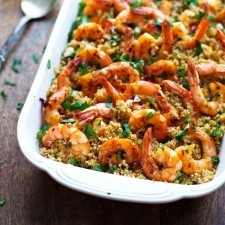 Garlic Butter Shrimp & Quinoa Casserole by Pinch of Yum
Garlic Butter Shrimp & Quinoa Casserole by Pinch of Yum
 Pork Chop Casserole by Bev Cooks
Pork Chop Casserole by Bev Cooks Eggplant Squash Tian by Love and Lemons
Eggplant Squash Tian by Love and Lemons
Stuffed Entrees
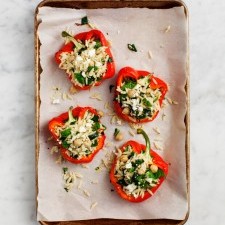 Vegetarian Stuffed Orzo Peppers by Love & Lemons
Vegetarian Stuffed Orzo Peppers by Love & Lemons
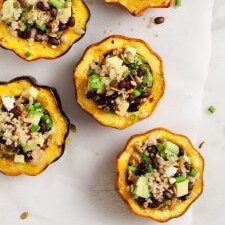 Avocado & Quinoa Stuffed Acorn Squash by Love & Lemons
Avocado & Quinoa Stuffed Acorn Squash by Love & Lemons
 Baked Mozzarella Chicken Rolls by Pinch of Yum
Baked Mozzarella Chicken Rolls by Pinch of Yum
Savory Pies
 Tomato & Onion Tart by Flour Arrangements
Tomato & Onion Tart by Flour Arrangements Chicken Pot Pie by Flour Arrangements
Chicken Pot Pie by Flour Arrangements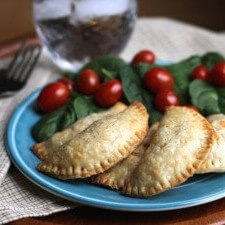 Savory Chicken Chili Hand Pies by Brittany’s Pantry
Savory Chicken Chili Hand Pies by Brittany’s Pantry
 Cheeseburger Pie by An Edible Mosaic
Cheeseburger Pie by An Edible Mosaic
 Easy Taco Pie by Damn Delicious
Easy Taco Pie by Damn Delicious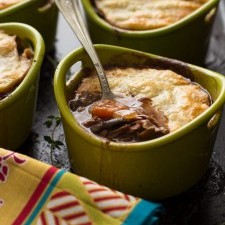 Steak & Mushroom Pie by One Sweet Mess
Steak & Mushroom Pie by One Sweet Mess
Risotto
 Vegetarian Barley Risotto by BetsyLife
Vegetarian Barley Risotto by BetsyLife
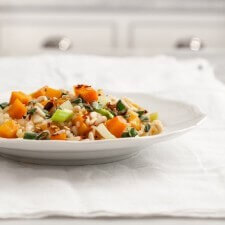 Butternut Squash & Leek Risotto by Love & Lemons
Butternut Squash & Leek Risotto by Love & Lemons Spinach Risotto by Living Lou
Spinach Risotto by Living Lou
Stir Fries
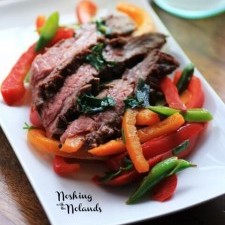 Ginger Beef Stir-Fry by Noshing with the Nolands
Ginger Beef Stir-Fry by Noshing with the Nolands Rapini Noodle Bowl by A House in the Hills
Rapini Noodle Bowl by A House in the Hills
Quick Chicken and Broccoli Stir Fry by Damn Delicious
Lasagna with a Twist
 Cheesy Chicken & Butternut Lasagna by Sweet Peas & Saffron
Cheesy Chicken & Butternut Lasagna by Sweet Peas & Saffron

Chicken Enchilada Lasagna by My Life as a Strawberry
 Chicken Cordon Bleu Lasagna by The Girl Who Ate Everything
Chicken Cordon Bleu Lasagna by The Girl Who Ate EverythingREAD THIS NEXT:
- 20 Apps You Can Play with Your Kids
- What Moms Want for Kids
- Make Holiday Travel with Kids Drama-Free
- Not Quite a Cat Lady
Read more from the CONNECT posts
This post was written by Suzanne Cowden exclusively for BonBon Break Media, LLC.




